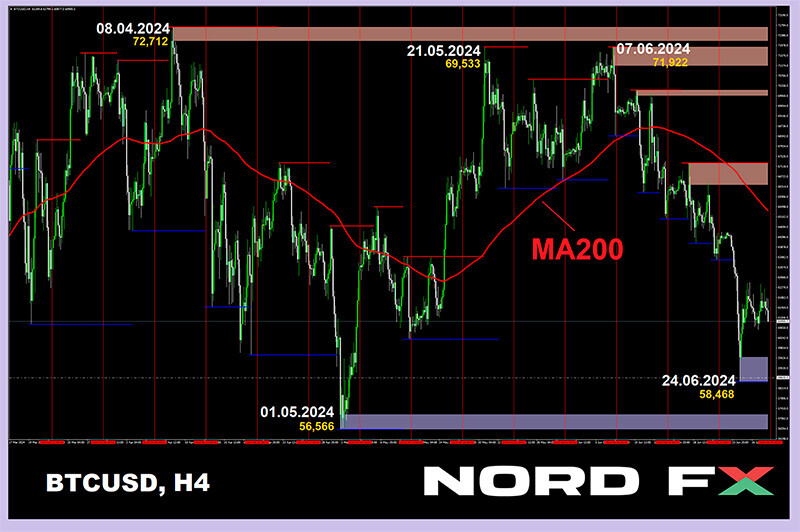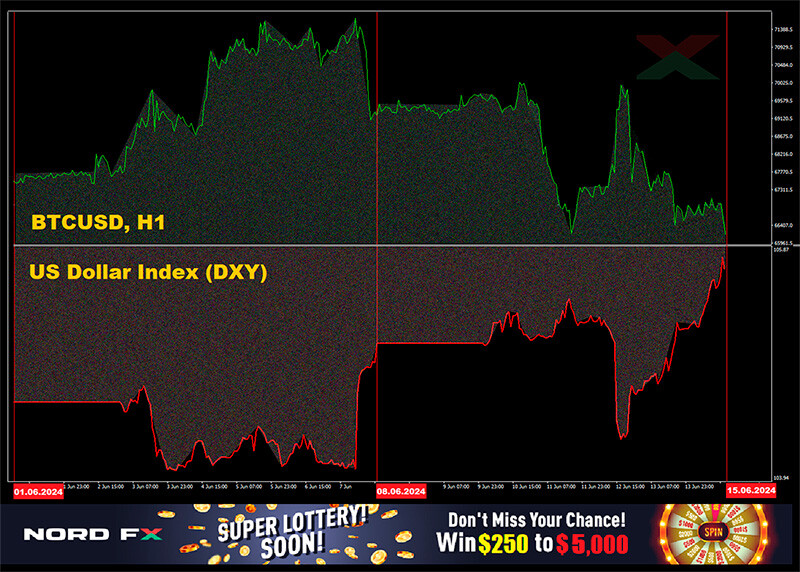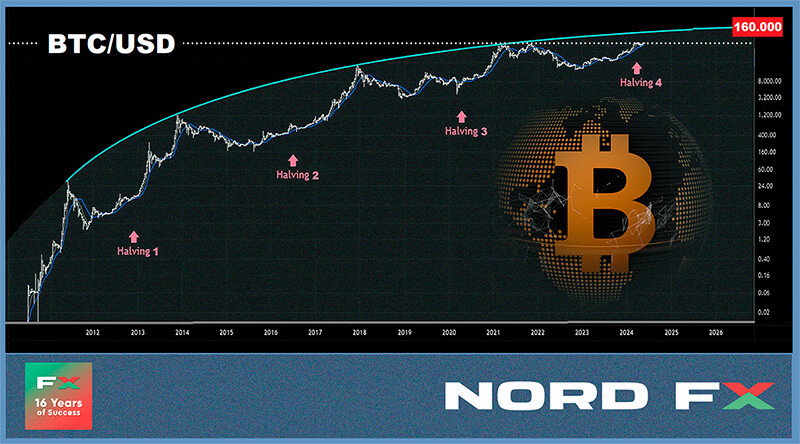16
Shares / Re: NordFX broker: News, Weekly Analytics
« on: June 30, 2024, 05:39:21 pm »
USD/JPY: Another Peak Conquered
Last week, 75% of analysts expecting new currency interventions voted for the USD/JPY pair's retreat south, while the remaining 25% pointed north. The minority, as is often the case with the Japanese currency, turned out to be right: no interventions occurred, and the pair reached another peak – 161.28.
Frankly, there's nothing to comment on here – everything has been discussed dozens and hundreds of times. The problem of the yen's weakening lies in the ultra-loose monetary policy of the Bank of Japan (BoJ). And as long as it does not decisively turn towards tightening, the national currency will continue to lose its positions. Of course, for a while, the Ministry of Finance and the Central Bank can support its exchange rate with currency interventions. But spending billions and billions on something that disappears like ripples on water after a few days – is there any point in that? Can this be called monetary policy?
If inflation falls in major competing countries, in Japan, it rises. According to data published on Friday, 28 June, the Consumer Price Index (CPI) in Tokyo for the year ending in June rose to 2.3% compared to 2.2% for the previous period. The core CPI inflation (excluding volatile food prices) also increased to 2.1% year-on-year, which is higher than both the forecast of 2.0% and the previous value of 1.9%. Another core CPI index for Tokyo (excluding food and energy prices) decreased in June to 1.8% year-on-year compared to the previous value of 2.2%.
Of course, these are not jumps that warrant sounding a loud alarm – all indicators are "hovering" around the target 2.0%. This allows Japanese officials to pause, without changing the vector of their monetary policy, and to limit themselves to verbal "interventions". Thus, Japan's Finance Minister Shunichi Suzuki once again stated that he is "deeply concerned about excessive and unilateral movements in the Forex market" and expressed hope that "trust in the Japanese currency is maintained". Suzuki's colleague, Cabinet Secretary Yoshimasa Hayashi, delivered almost the same speech word for word. However, he added that the authorities "will take appropriate measures regarding excessive currency movements", hinting at another currency intervention.
This hint from Yoshimasa Hayashi scared 60% of experts who voted for the pair's southward movement and yen strengthening, 20% pointed north, and 20% took a neutral position. The opinion of the indicators is unambiguous, as they have never heard of interventions. Therefore, all 100% of trend indicators and oscillators on D1 are green, although a quarter of the latter are in the overbought zone. The nearest support level is around 160.25, followed by 159.20, 158.65, 157.60-157.80, 156.60, 155.45-155.70, 154.50-154.70, 153.60, 153.00, 151.90-152.15, 150.80-151.00. The nearest resistance is in the 160.85 zone, followed by 161.30 and 162.50.
In the upcoming week, the calendar highlights Monday, 01 July. On this day, the Tankan Large Manufacturers Index will be published. No other important macro statistics regarding the state of the Japanese economy are planned for the coming days.
CRYPTOCURRENCIES: Causes and Consequences of "Black Monday" on 24 June

Monday, 24 June, presented investors with a very unpleasant surprise – on this day, bitcoin's price fell below $60,000 for the first time since 03 May, reaching $58,468 at one point. Ethereum, in turn, fell below $3,250. Analysts highlight several reasons for the active sell-offs, noting that they reflect overall instability in global financial markets and uncertainty about monetary and regulatory policies in several leading countries, especially China and the US. However, there are also more specific factors that contributed to the development of the bearish trend.
In mid-June, the German government began selling off a huge amount of bitcoins (about 50,000 BTC) confiscated in January. Panic sentiment sharply intensified after the announcement on 24 June that creditor payments for the bankrupt crypto exchange Mt.Gox would begin in early July. The total amount of funds to be distributed among former clients is 162,100 BTC, roughly $10 billion. Bitcoin responded to this news with an 8% drop. It’s no surprise – such a volume of coins flooding the free market can seriously knock down prices. In the derivatives market, long positions worth $177 million were forcibly liquidated, and the total financing rate for futures contracts turned negative for the first time in June, indicating that sales exceeded purchases.
It is precisely on the expectations of Mt.Gox debt payments that the flagship crypto asset's quotes reached the lowest level in the past eight weeks last Monday. In this situation, two things are encouraging. Firstly, the deadline for repayment falls on 31 October, and it's possible that payments will be made in parts over four months rather than all at once. And secondly, there is hope that not all creditors will rush to convert their bitcoins into fiat, but will hold onto them, hoping for price growth.
In addition to the above, BTC miners exerted some downward pressure on the market. It became known that their coin reserves reached a 14-year low, as they had to sell a significant amount of BTC due to the April halving to cover operational expenses. Recall that the cost of mining bitcoin, according to JPMorgan analysts, is $53,000. Historically, this cost level is a strong support for BTC/USD. However, even in March, JPMorgan did not rule out that after the halving, bitcoin could temporarily fall to $42,000.
In the absence of positive signals, the demand for spot bitcoin ETFs continues to decline, major market participants slow down their activity, and start to take profits. This also pressures the prices. CEO of investment company CryptoQuant Ki Young Ju calculated that over the past two weeks, bitcoin whales and miners set a record by selling coins worth $1.2 billion.
According to 10x Research, all last week, US spot BTC ETFs recorded investor outflows, and on 21 June, net outflow exceeded $105 million. 10x Research believes that bitcoin will now need to find a new price range to stabilize the decline and then find growth catalysts. In the medium term, according to 10x Research analysts, it is not worth expecting BTC to return above $70,000.
Popular analyst Matthew Hyland noted that the combined bitcoin balance on centralized exchanges reached a multi-year low. In theory, this could be seen as a bullish signal, but the crypto market leader is not yet eager to show an upward trend. Naturally, the publication of key US economic data could serve as a vector for further cryptocurrency movements. If the Fed takes its first step in easing its monetary policy in September, it could support risky assets, including bitcoin. According to Cryptology experts, the chances of bitcoin reaching a new all-time high by the end of September are quite high, and what is happening now is a phase of accumulation.
Despite the current decline, many investors remain optimistic, citing the cyclical nature of the crypto market. They also do not forget about the US elections. For example, former Goldman Sachs CEO Raoul Pal predicted significant bitcoin and cryptocurrency market growth in Q4 2024. In an episode of The Wolf Of All Streets podcast, the financier noted that risky assets like bitcoin usually rally against the backdrop of US presidential elections. "The final quarter of an election year is a real 'banana zone' for all assets. It always is," Pal optimistically stated, noting that the "banana zone" for cryptocurrencies in autumn is much more pronounced than, for example, for the Nasdaq index.
Bitcoin was also supported by billionaire Michael Saylor. His company, MicroStrategy, is one of the largest bitcoin holders in the world, with 205,000 BTC on its balance sheet. Despite the negative trend, it increased its reserves by another 11,931 BTC (over $700 million) in the past month alone. Saylor is convinced of the first cryptocurrency's ability to grow to $10 million with support from China and other factors. He believes that in the future, governments, especially China, will fully embrace the first cryptocurrency and integrate it into the state infrastructure. The entrepreneur declared all pre-bitcoin economic instruments obsolete. "Before Satoshi Nakamoto, economics was a pseudoscience. All economists before Satoshi tried to develop economic laws with shells, glass beads, pieces of paper, and credit instruments," the businessman wrote, calling bitcoin a "perfect asset."
In previous reviews, we already wrote that the launch of exchange-traded spot ETFs on Ethereum could give a certain boost to the digital asset market. On 25 June, SEC (US Securities and Exchange Commission) Chairman Gary Gensler noted that the registration process for new ETFs is "going smoothly," and the approval date depends on how quickly applicants submit adjusted S-1 forms. Bloomberg analysts call 02 July the expected approval date for new products. Reuters, citing anonymous sources, reports that a consensus has been reached between fund managers and the SEC in negotiations, and only the "final touches" remain.
Co-founder of venture company Mechanism Capital Andrew Kang stated that after the approval of ETH-ETF, Ethereum's rate could correct by 30%, falling to $2,400. In his opinion, at this stage, the main altcoin attracts much less attention from institutional investors compared to bitcoin. Based on this, ETH-ETF will attract only 15% of funds compared to what BTC-ETF received at the start.
Kang noted that to increase Ethereum's attractiveness among investors, its ecosystem needs to be positioned as a decentralized financial settlement layer, a global computer, or a Web3 application store. At the same time, it will be difficult to sell new ideas for Ethereum's application to funds, as the asset is perceived by investors as an overvalued stock of a large technology company.
Significantly more positively views the future of Ethereum Matt Hougan, CIO of Bitwise, a company managing cryptocurrency funds. In his opinion, the appearance of a long-awaited exchange product is undoubtedly a positive factor, and the net inflow of investments into ETH-ETF over the first 18 months will amount to $15 billion. In his analysis, he relies on the experience of Canada and the EU, where in similar products the inflow ratio for Ethereum and Bitcoin is approximately 1 to 4 (i.e., 25%). In other words, if in the first quarter of work for spot Bitcoin-ETF the total inflow was $26.9 billion, for Ethereum it is expected to be at the level of $6.7 billion. In this case, in three months of work, the leading altcoin could rise to $4,400-5,000.
CEO of SkyBridge Capital Anthony Scaramucci believes that the price of Ethereum could rise even higher, reaching $10,000-12,000. Regarding bitcoin, the entrepreneur allows for its growth to $170,000-250,000. The main driver, in his opinion, will be the further institutional acceptance of cryptocurrency. Scaramucci called the approval of spot exchange ETFs an important regulatory barrier breakthrough for attracting new capital. Thanks to this, in his opinion, the share of digital gold in the portfolios of major players will soon be about 3%.
As of the evening of Friday, 28 June, BTC/USD is trading at $60,190, and ETH/USD is in the $3,390 zone. The total crypto market capitalization is $2.24 trillion ($2.34 trillion a week ago). The bitcoin Fear & Greed Index (Crypto Fear & Greed Index) has dropped from 63 to 47 points over the past 7 days, moving from the Greed zone to the Neutral zone.
In conclusion, here is another observation from Matt Hougan. The CIO of Bitwise presented three reasons why long-term investments in both bitcoin and Ethereum are more advantageous compared to investing only in bitcoin. These are: 1. portfolio diversification 2. the opportunity to earn on very different ecosystems and 3. economic benefit.
Considering the difference in the capitalization levels of bitcoin and Ethereum, Hougan believes that 75% of the capital should be invested in BTC and 25% in ETH. According to calculations, over the period from May 2020 to May 2024, the yield of such an investment portfolio is 3% per annum higher than one that only contains bitcoin. However, Hougan acknowledges that in the shorter term, a portfolio including 100% BTC outperforms a diversified one. Moreover, investing only in bitcoin carries fewer risks due to its higher market capitalization and features such as limited coin issuance and a phased reduction in the inflation rate to zero.
NordFX Analytical Group
Notice: These materials are not investment recommendations or guidelines for working in financial markets and are intended for informational purposes only. Trading in financial markets is risky and can result in a complete loss of deposited funds.
#eurusd #gbpusd #usdjpy #btcusd #ethusd #ltcusd #xrpusd #forex #forex_example #signals #cryptocurrencies #bitcoin #stock_market
Last week, 75% of analysts expecting new currency interventions voted for the USD/JPY pair's retreat south, while the remaining 25% pointed north. The minority, as is often the case with the Japanese currency, turned out to be right: no interventions occurred, and the pair reached another peak – 161.28.
Frankly, there's nothing to comment on here – everything has been discussed dozens and hundreds of times. The problem of the yen's weakening lies in the ultra-loose monetary policy of the Bank of Japan (BoJ). And as long as it does not decisively turn towards tightening, the national currency will continue to lose its positions. Of course, for a while, the Ministry of Finance and the Central Bank can support its exchange rate with currency interventions. But spending billions and billions on something that disappears like ripples on water after a few days – is there any point in that? Can this be called monetary policy?
If inflation falls in major competing countries, in Japan, it rises. According to data published on Friday, 28 June, the Consumer Price Index (CPI) in Tokyo for the year ending in June rose to 2.3% compared to 2.2% for the previous period. The core CPI inflation (excluding volatile food prices) also increased to 2.1% year-on-year, which is higher than both the forecast of 2.0% and the previous value of 1.9%. Another core CPI index for Tokyo (excluding food and energy prices) decreased in June to 1.8% year-on-year compared to the previous value of 2.2%.
Of course, these are not jumps that warrant sounding a loud alarm – all indicators are "hovering" around the target 2.0%. This allows Japanese officials to pause, without changing the vector of their monetary policy, and to limit themselves to verbal "interventions". Thus, Japan's Finance Minister Shunichi Suzuki once again stated that he is "deeply concerned about excessive and unilateral movements in the Forex market" and expressed hope that "trust in the Japanese currency is maintained". Suzuki's colleague, Cabinet Secretary Yoshimasa Hayashi, delivered almost the same speech word for word. However, he added that the authorities "will take appropriate measures regarding excessive currency movements", hinting at another currency intervention.
This hint from Yoshimasa Hayashi scared 60% of experts who voted for the pair's southward movement and yen strengthening, 20% pointed north, and 20% took a neutral position. The opinion of the indicators is unambiguous, as they have never heard of interventions. Therefore, all 100% of trend indicators and oscillators on D1 are green, although a quarter of the latter are in the overbought zone. The nearest support level is around 160.25, followed by 159.20, 158.65, 157.60-157.80, 156.60, 155.45-155.70, 154.50-154.70, 153.60, 153.00, 151.90-152.15, 150.80-151.00. The nearest resistance is in the 160.85 zone, followed by 161.30 and 162.50.
In the upcoming week, the calendar highlights Monday, 01 July. On this day, the Tankan Large Manufacturers Index will be published. No other important macro statistics regarding the state of the Japanese economy are planned for the coming days.
CRYPTOCURRENCIES: Causes and Consequences of "Black Monday" on 24 June

Monday, 24 June, presented investors with a very unpleasant surprise – on this day, bitcoin's price fell below $60,000 for the first time since 03 May, reaching $58,468 at one point. Ethereum, in turn, fell below $3,250. Analysts highlight several reasons for the active sell-offs, noting that they reflect overall instability in global financial markets and uncertainty about monetary and regulatory policies in several leading countries, especially China and the US. However, there are also more specific factors that contributed to the development of the bearish trend.
In mid-June, the German government began selling off a huge amount of bitcoins (about 50,000 BTC) confiscated in January. Panic sentiment sharply intensified after the announcement on 24 June that creditor payments for the bankrupt crypto exchange Mt.Gox would begin in early July. The total amount of funds to be distributed among former clients is 162,100 BTC, roughly $10 billion. Bitcoin responded to this news with an 8% drop. It’s no surprise – such a volume of coins flooding the free market can seriously knock down prices. In the derivatives market, long positions worth $177 million were forcibly liquidated, and the total financing rate for futures contracts turned negative for the first time in June, indicating that sales exceeded purchases.
It is precisely on the expectations of Mt.Gox debt payments that the flagship crypto asset's quotes reached the lowest level in the past eight weeks last Monday. In this situation, two things are encouraging. Firstly, the deadline for repayment falls on 31 October, and it's possible that payments will be made in parts over four months rather than all at once. And secondly, there is hope that not all creditors will rush to convert their bitcoins into fiat, but will hold onto them, hoping for price growth.
In addition to the above, BTC miners exerted some downward pressure on the market. It became known that their coin reserves reached a 14-year low, as they had to sell a significant amount of BTC due to the April halving to cover operational expenses. Recall that the cost of mining bitcoin, according to JPMorgan analysts, is $53,000. Historically, this cost level is a strong support for BTC/USD. However, even in March, JPMorgan did not rule out that after the halving, bitcoin could temporarily fall to $42,000.
In the absence of positive signals, the demand for spot bitcoin ETFs continues to decline, major market participants slow down their activity, and start to take profits. This also pressures the prices. CEO of investment company CryptoQuant Ki Young Ju calculated that over the past two weeks, bitcoin whales and miners set a record by selling coins worth $1.2 billion.
According to 10x Research, all last week, US spot BTC ETFs recorded investor outflows, and on 21 June, net outflow exceeded $105 million. 10x Research believes that bitcoin will now need to find a new price range to stabilize the decline and then find growth catalysts. In the medium term, according to 10x Research analysts, it is not worth expecting BTC to return above $70,000.
Popular analyst Matthew Hyland noted that the combined bitcoin balance on centralized exchanges reached a multi-year low. In theory, this could be seen as a bullish signal, but the crypto market leader is not yet eager to show an upward trend. Naturally, the publication of key US economic data could serve as a vector for further cryptocurrency movements. If the Fed takes its first step in easing its monetary policy in September, it could support risky assets, including bitcoin. According to Cryptology experts, the chances of bitcoin reaching a new all-time high by the end of September are quite high, and what is happening now is a phase of accumulation.
Despite the current decline, many investors remain optimistic, citing the cyclical nature of the crypto market. They also do not forget about the US elections. For example, former Goldman Sachs CEO Raoul Pal predicted significant bitcoin and cryptocurrency market growth in Q4 2024. In an episode of The Wolf Of All Streets podcast, the financier noted that risky assets like bitcoin usually rally against the backdrop of US presidential elections. "The final quarter of an election year is a real 'banana zone' for all assets. It always is," Pal optimistically stated, noting that the "banana zone" for cryptocurrencies in autumn is much more pronounced than, for example, for the Nasdaq index.
Bitcoin was also supported by billionaire Michael Saylor. His company, MicroStrategy, is one of the largest bitcoin holders in the world, with 205,000 BTC on its balance sheet. Despite the negative trend, it increased its reserves by another 11,931 BTC (over $700 million) in the past month alone. Saylor is convinced of the first cryptocurrency's ability to grow to $10 million with support from China and other factors. He believes that in the future, governments, especially China, will fully embrace the first cryptocurrency and integrate it into the state infrastructure. The entrepreneur declared all pre-bitcoin economic instruments obsolete. "Before Satoshi Nakamoto, economics was a pseudoscience. All economists before Satoshi tried to develop economic laws with shells, glass beads, pieces of paper, and credit instruments," the businessman wrote, calling bitcoin a "perfect asset."
In previous reviews, we already wrote that the launch of exchange-traded spot ETFs on Ethereum could give a certain boost to the digital asset market. On 25 June, SEC (US Securities and Exchange Commission) Chairman Gary Gensler noted that the registration process for new ETFs is "going smoothly," and the approval date depends on how quickly applicants submit adjusted S-1 forms. Bloomberg analysts call 02 July the expected approval date for new products. Reuters, citing anonymous sources, reports that a consensus has been reached between fund managers and the SEC in negotiations, and only the "final touches" remain.
Co-founder of venture company Mechanism Capital Andrew Kang stated that after the approval of ETH-ETF, Ethereum's rate could correct by 30%, falling to $2,400. In his opinion, at this stage, the main altcoin attracts much less attention from institutional investors compared to bitcoin. Based on this, ETH-ETF will attract only 15% of funds compared to what BTC-ETF received at the start.
Kang noted that to increase Ethereum's attractiveness among investors, its ecosystem needs to be positioned as a decentralized financial settlement layer, a global computer, or a Web3 application store. At the same time, it will be difficult to sell new ideas for Ethereum's application to funds, as the asset is perceived by investors as an overvalued stock of a large technology company.
Significantly more positively views the future of Ethereum Matt Hougan, CIO of Bitwise, a company managing cryptocurrency funds. In his opinion, the appearance of a long-awaited exchange product is undoubtedly a positive factor, and the net inflow of investments into ETH-ETF over the first 18 months will amount to $15 billion. In his analysis, he relies on the experience of Canada and the EU, where in similar products the inflow ratio for Ethereum and Bitcoin is approximately 1 to 4 (i.e., 25%). In other words, if in the first quarter of work for spot Bitcoin-ETF the total inflow was $26.9 billion, for Ethereum it is expected to be at the level of $6.7 billion. In this case, in three months of work, the leading altcoin could rise to $4,400-5,000.
CEO of SkyBridge Capital Anthony Scaramucci believes that the price of Ethereum could rise even higher, reaching $10,000-12,000. Regarding bitcoin, the entrepreneur allows for its growth to $170,000-250,000. The main driver, in his opinion, will be the further institutional acceptance of cryptocurrency. Scaramucci called the approval of spot exchange ETFs an important regulatory barrier breakthrough for attracting new capital. Thanks to this, in his opinion, the share of digital gold in the portfolios of major players will soon be about 3%.
As of the evening of Friday, 28 June, BTC/USD is trading at $60,190, and ETH/USD is in the $3,390 zone. The total crypto market capitalization is $2.24 trillion ($2.34 trillion a week ago). The bitcoin Fear & Greed Index (Crypto Fear & Greed Index) has dropped from 63 to 47 points over the past 7 days, moving from the Greed zone to the Neutral zone.
In conclusion, here is another observation from Matt Hougan. The CIO of Bitwise presented three reasons why long-term investments in both bitcoin and Ethereum are more advantageous compared to investing only in bitcoin. These are: 1. portfolio diversification 2. the opportunity to earn on very different ecosystems and 3. economic benefit.
Considering the difference in the capitalization levels of bitcoin and Ethereum, Hougan believes that 75% of the capital should be invested in BTC and 25% in ETH. According to calculations, over the period from May 2020 to May 2024, the yield of such an investment portfolio is 3% per annum higher than one that only contains bitcoin. However, Hougan acknowledges that in the shorter term, a portfolio including 100% BTC outperforms a diversified one. Moreover, investing only in bitcoin carries fewer risks due to its higher market capitalization and features such as limited coin issuance and a phased reduction in the inflation rate to zero.
NordFX Analytical Group
Notice: These materials are not investment recommendations or guidelines for working in financial markets and are intended for informational purposes only. Trading in financial markets is risky and can result in a complete loss of deposited funds.
#eurusd #gbpusd #usdjpy #btcusd #ethusd #ltcusd #xrpusd #forex #forex_example #signals #cryptocurrencies #bitcoin #stock_market












